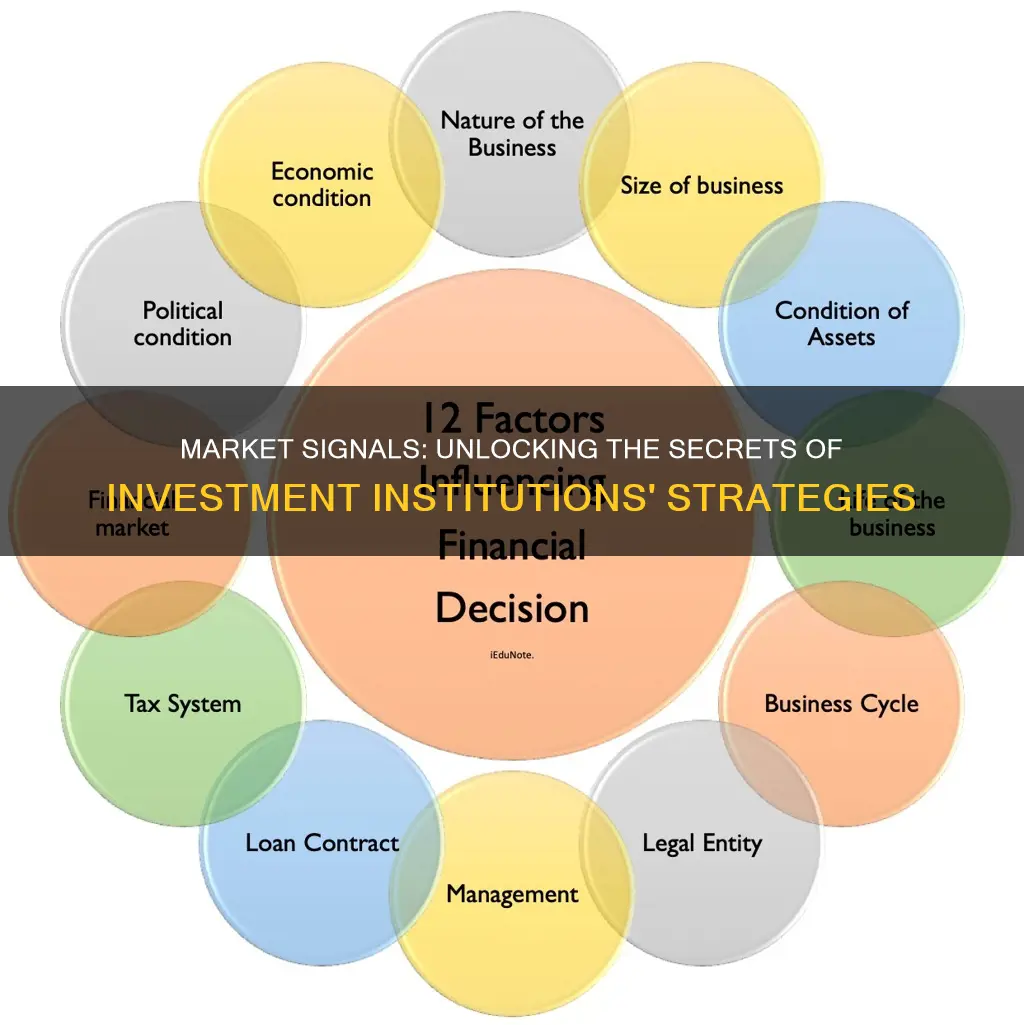
Investment institutions use a variety of signals to determine when to buy and sell. These signals can be based on technical analysis, fundamental analysis, quantitative analysis, economics, or even sentiment measures. One commonly used signal is the Relative Strength Index (RSI), which measures the magnitude of recent price changes to analyse overbought or oversold conditions. A high RSI can indicate that a stock is overbought and may be a good time to sell, while a low RSI could signal that a stock is oversold and present a buying opportunity. Other signals include a stock's price-to-earnings ratio, short interest, and news such as executive scandals or investigations. Institutions often take weeks or months to build their positions, and steady buying can indicate upward propulsion and support for a stock.
| Characteristics | Values |
|---|---|
| Buy signals | Chart patterns, technical indicators, intrinsic value |
| Sell signals | Pre-determined percentage decline in asset's value, technical indicators, fundamental changes in the asset, trailing stop-loss |
| Trading signals | Simple: earnings reports, volume surge |
| Complex: existing signals, technical analysis, fundamental analysis, quantitative analysis, economics, sentiment measures |
What You'll Learn

Chart patterns
There are thousands of chart patterns, but most fall under two categories: continuation patterns and reversal patterns. Continuation patterns are often a pause in a trend, indicating that the trend direction will continue after price breaks out of the continuation pattern. Reversal patterns indicate a change in trend and are usually considered top and bottom formations.
- Cups: Cup-with-Handle and Cup-without-Handle. The cup-with-handle pattern features a prior uptrend of at least 30%, with the depth of the base between 15-30% (15-50% in a severe bear market). The minimum length for this pattern is 7 weeks, with the handle forming in the upper half of the base. The handle is a mild pullback on relatively light volume, shaking out weaker holders. The ideal buy point is 10 cents above the peak in the handle, with the buying range up to 5% above this.
- Double Bottom Reversal: A reversal pattern that looks like a 'W', indicating two unsuccessful attempts to break through the support level. After the second unsuccessful attempt, the market price shifts towards an uptrend.
- Head and Shoulders: A pattern that tries to predict a bull-to-bear market reversal. It is characterised by a large peak with two smaller peaks on either side, with all three levels falling back to the same support level. The trend then typically breaks out in a downward motion.
- Rounding Top or Bottom: A rounding bottom or cup indicates a bullish upward trend, whereas a rounding top indicates a bearish downward trend. Traders can buy in the middle of the U-shape, capitalising on the trend that follows as it breaks through resistance levels.
- Ascending Triangle: A bullish continuation pattern that signifies a breakout is likely where the triangle lines converge. It is drawn with a horizontal resistance line and an ascending uptrend line.
- Symmetrical Triangle: This pattern has two converging trend lines, indicating a breakout in either direction. The breakout often follows the general market trend.
- Pennants: Drawn with two converging trend lines, often after strong upward or downward moves. The trend then continues in the same direction.
Silver Linings: Exploring the Best Cheap Silver Coins for Savvy Investors
You may want to see also

Technical indicators
There are several types of technical indicators, which can be broadly grouped into two main categories: overlays and oscillators. Overlays are plotted over the top of the prices on a stock chart and use the same scale as prices. Examples include moving averages and Bollinger Bands. Oscillators, on the other hand, oscillate between a local minimum and maximum and are plotted above or below a price chart. Examples include the stochastic oscillator, Moving Average Convergence Divergence (MACD), and Relative Strength Index (RSI).
Some of the most common technical indicators include:
- On-Balance Volume (OBV): Measures the positive and negative flow of volume in a security over time, acting as a trend confirmation tool.
- Accumulation/Distribution Line: Used to determine the money flow in and out of a security by accounting for the trading range and the closing price.
- Average Directional Index (ADX): Measures the strength and momentum of a trend. When the ADX is above 40, the trend is considered strong, while an ADX below 20 indicates a weak or non-trending market.
- Relative Strength Index (RSI): Has several uses, including as an overbought and oversold indicator. For example, when the RSI is above 70, the asset is considered overbought and may decline.
- Stochastic Oscillator: Measures the current price relative to the price range over a number of periods. It is often used as an overbought and oversold indicator, with values above 80 considered overbought and levels below 20 considered oversold.
Best Asian Investment Spots for Your $100K
You may want to see also

Intrinsic value
Financial analysts use cash flow to determine the intrinsic value of a company or stock. This is known as discounted cash flow analysis, and it is the metric often used in calculations for intrinsic value.
The intrinsic value of a company is a theoretical concept, and there is no universal standard for calculating it. Different formulas are used to determine the ‘true value’ of a stock, and this will vary based on who is calculating it and what their assumptions are.
There are several methods for calculating intrinsic value, including:
- Discounted cash flow model
- Price-to-earnings model
- Dividend discount model
- Asset-based valuation
The discounted cash flow model is the most common valuation formula. It adds up the forecasted cash flows of a company to determine its value. The future cash flows are discounted using a required rate of return to determine the value of a company based on its ability to generate cash.
The price-to-earnings model uses the price-earnings ratio, earnings per share, and growth rate to assess the intrinsic value of a stock.
The dividend discount model can only be used if the company being analysed issues regular dividends. It calculates the fundamental value of a security, factoring in variables that largely pertain to cash, such as dividends and future cash flows.
The asset-based valuation sums up all the company’s assets and then subtracts its total liabilities. It does not account for growth in the company.
Planning for the Golden Years: Strategies for Late-Start Retirement Investing
You may want to see also

Fundamental analysis
Fundamental analysts build financial models to value an asset based on certain variables. They may use discounted cash flow analysis, which uses a breakdown of company earnings and free cash flow to generate a market valuation through discounting. This methodology generates a range of values for a security using different assumptions. Various scenarios and assumptions can generate price level ranges, which help analysts decide whether to buy or sell a security. For example, a company's total debt to assets rising above a certain level could be a signal to sell.
Other parameters that fundamental analysts may use include earnings growth and price-earnings ratios. Analysts may sell when earnings growth starts to decline or when the price-earnings ratio reaches a level that does not justify future earnings prospects.
Litecoin's Future: Why the Bullish Outlook Has Investors Smiling
You may want to see also

Technical analysis
- Chart patterns: For example, an ascending triangle pattern is a buy signal when the price breaks out from the upper trend line resistance.
- Technical indicators: For example, the relative strength index (RSI) is a popular indicator that can be used to buy when it moves below 30.0, or sell when it moves above 70.0. Stochastics is another popular indicator, which measures the relationship between a stock's closing price and its price range over a set period.
- Moving averages: A common strategy is to buy when a stock price crosses above a moving average, and sell when it crosses below.
- Volume: A surge in volume can indicate a new move in the market.
- Interest rates: Changes in interest rates can suggest changes in stock and commodity markets.
- Volatility: Extreme highs or lows in volatility can be used as a trigger.
- Cycles: For example, the seasonal cycle for stocks is to sell in May and then buy back in.
- Sentiment extremes: Used as a contrarian indicator, excessive bullishness can suggest market tops, while excessive bearishness can lead to market bottoms.
Inheritance Dilemma: Invest or Pay Off Mortgage?
You may want to see also
Frequently asked questions
A trade signal is a trigger to either buy or sell a security or asset, generated by analysis. This analysis can be performed by a human using technical indicators or by a machine using mathematical algorithms.
Buy signals can be generated through the use of charts, technical indicators, or intrinsic value calculations. Chart patterns such as ascending triangles are a common buy signal. Technical indicators like the relative strength index (RSI) can also be used, with an RSI below 30 often signalling a buy. Additionally, investors can calculate a stock's intrinsic value and buy when the market price falls below this value.
Sell signals can be based on fundamental or technical analysis. Fundamental analysts may generate sell signals when a security's value reaches a certain level, such as a high price-to-earnings ratio or high short interest. Technical analysts use charting techniques and patterns, such as a decline below a support level or a triangle pattern, to generate sell signals.







